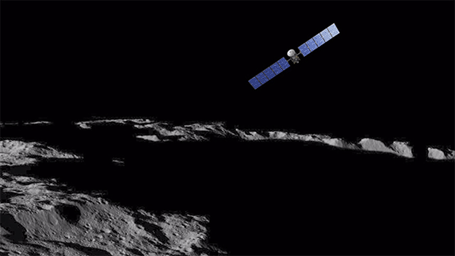Click here for the animation
Transcript
This is Ceres, the dwarf planet that Dawn's been orbiting for more than a year now, providing us with fascinating views of an alien world. During its exploration, Dawn has moved closer and closer, allowing us to get a broad overview and then see exquisite detail.
This is Ahuna Mons, the highest mountain on Ceres. Towering in an otherwise unremarkable area, it seems very odd that it rises so sharply. And geologists still don't know why. On its steepest side it soars 3 miles, higher than any peak in the continental United States.
Haulani Crater, one of the brightest regions on Ceres. It's about 21 miles across. Its well-defined shape indicates it's relatively young, the impact that formed it having occurred in recent geological times. You can see a substantial amount of bright material, which the latest analyses indicate may be a kind of salt.
This is Oxo Crater, which shows more of this intriguing bright material inside and out, as well as a peculiar shape. At 6 miles in diameter, this is the second-brightest feature on Ceres. You can see next to it an intriguing linear feature called a 'slump,' where a mass of material has dropped below the surface.
This is Urvara Crater, about 105 miles in diameter, although not the largest on Ceres. Although many craters have a mountain in the center, Urvara has a prominent double peak surrounded by rough terrain and linear parallel grooves.
Occator Crater: 57 miles across and 2 miles deep. As Dawn closed in what initially looked like one spot became two and, eventually, a multitude of features. This reflective material makes it the brightest region on Ceres. The crater also appears to be among the youngest on Ceres.
Dawn mission scientists estimate its age to be about 80 million years, which is quite young in geological time. Dawn is now orbiting only 240 miles above Ceres, which is closer than the Space Station is to Earth. And it will continue to return spectacular views.
End transcript
Dawn's mission is managed by JPL for NASA's Science Mission Directorate in Washington. Dawn is a project of the directorate's Discovery Program, managed by NASA's Marshall Space Flight Center in Huntsville, Alabama. UCLA is responsible for overall Dawn mission science. Orbital ATK, Inc., in Dulles, Virginia, designed and built the spacecraft. The German Aerospace Center, the Max Planck Institute for Solar System Research, the Italian Space Agency and the Italian National Astrophysical Institute are international partners on the mission team. For a complete list of acknowledgments, see http://dawn.jpl.nasa.gov/mission.
For more information about the Dawn mission, visit http://dawn.jpl.nasa.gov.

 Planetary Data System
Planetary Data System












